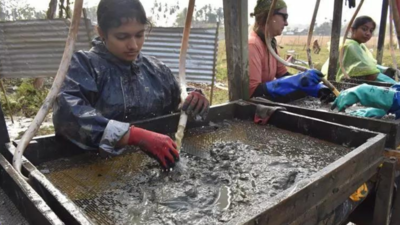- News
- City News
- ahmedabad News
- Human remains, boot & parachute fragments: How Gujarat varsity helped US identify 3 missing WWII airmen
Trending
Human remains, boot & parachute fragments: How Gujarat varsity helped US identify 3 missing WWII airmen
In a joint effort by National Forensic Sciences University and the University of Nebraska-Lincoln, the identification of three US soldiers who died in a 1944 plane crash in Assam, India, has been achieved through forensic archaeology. The success evokes significant emotion for families awaiting closure for decades and opens new avenues for forensic expertise in India.
AHMEDABAD: It was the summer of 1944 during World War II when a B-29 Superfortress airplane, part of the 444th Bombardment Group (Very Heavy) of the US armed forces, was returning to its base after a bombing raid on the Imperial Iron and Steel Works at Yawata, Kyushu Island in Japan. The airplane crashed in the rice fields of Sapekhati in today's northern Assam, and all 11 crew members aboard were killed due to the impact.

Closure after eight decades
After the war was over, US teams visited the site and recovered the remains of only seven soldiers.
Eighty years later, in a joint effort by Gandhinagar-based National Forensic Sciences University (NFSU) and the US-based University of Nebraska-Lincoln (UNL), as part of a tripartite agreement with the Defense POW/MIA Accounting Agency (DPAA) of the United States, the site was visited again to resume the search for the other four soldiers.
According to the DPAA website, the three soldiers are identified as Flight Officer Chester L Rinke, 33, of Marquette, Michigan; Second Lieutenant Walter B Miklosh, 21, of Chicago, Illinois; and Sergeant Donal C Aiken, 33, of Everett, Washington. They were part of the bombardment mission and died in the airplane crash. Officials associated with the process said that the remains will be sent to the US with due procedure.
Dr J M Vyas, vice-chancellor of NFSU, said the project is unique as it involved the identification and analysis of samples from 80 years ago. He announced the success of the collaboration at a recently organised convocation.
"Standard archaeological methods were used to excavate the site of the crash and its periphery. However, since the sediments were saturated with water, a wet-screening operation was used to force water through a series of pumps and tubes and force the mud through 6mm mesh screens to remove the mud and find any small piece of evidence," said Dr Gargi Jani, lead of the project from NFSU. "A stepped excavation method was used as a safety measure to avoid collapse as trenches were often over 3 metres deep."
The DPAA website mentioned that the identification was carried out based on material and anthropological evidence along with techniques such as mitochondrial DNA (mtDNA) analysis and Y chromosome (Y-STR) analysis by scientists from the Armed Forces Medical Examiner System.
Prof William Belcher, the lead from UNL, in his experiences chronicled earlier, wrote that it indeed becomes an emotional moment for the families of soldiers as they have waited for decades to find closure.
"It was a unique collaborative project, and its success has opened doors for professionals and students. We have already launched a course for capacity building of forensic archaeology and anthropology in the Indian context. Such expertise can be employed for complex forensic and archaeological challenges such as burial sites, war crimes, and improving the way human remains are handled," said Dr Vyas.

About the Author
Parth ShastriEnd of Article
FOLLOW US ON SOCIAL MEDIA






